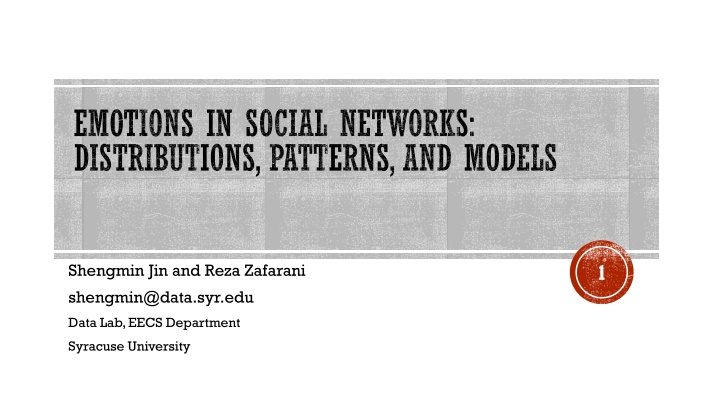
Emotions in Social Networks: Distributions, Patterns, and Models
Explore the distribution, patterns, and models of emotions in social networks across different levels, from individual users to entire communities. Discover insights on how emotions vary, evolve over time, and interact with social ties. Access a rich dataset spanning over 10 years of LiveJournal data, shedding light on the emotional landscape of online social interactions.
Download Presentation

Please find below an Image/Link to download the presentation.
The content on the website is provided AS IS for your information and personal use only. It may not be sold, licensed, or shared on other websites without obtaining consent from the author. If you encounter any issues during the download, it is possible that the publisher has removed the file from their server.
You are allowed to download the files provided on this website for personal or commercial use, subject to the condition that they are used lawfully. All files are the property of their respective owners.
The content on the website is provided AS IS for your information and personal use only. It may not be sold, licensed, or shared on other websites without obtaining consent from the author.
E N D
Presentation Transcript
EMOTIONS IN SOCIAL NETWORKS: DISTRIBUTIONS, PATTERNS, AND MODELS 1 Shengmin Jin and Reza Zafarani shengmin@data.syr.edu Data Lab, EECS Department Syracuse University
EMOTIONS AND SOCIAL NETWORKS Our goal is to understand how emotions vary across users; evolve over time; and are connected to social ties Five Levels to study social network data User Ego Triad Community Whole-Network 2
DATASET Spanning more than 10 years of LiveJournal data. Posts with emotions directly provided by users Community memberships for all users. The dataset is released on http://data.syr.edu/get/EmotionPatterns 3
USER LEVEL We determine how positive or negative a user is in general. Subjective Well-Being (SWB) where and represent the number of positive and negative posts for user u . 4
USER LEVEL Emotions change over time or with more activity 5
EGO LEVEL Undirected ego networks (Friendship) Directed ego networks (Follower/Followee) Only positive users demonstrate assortativity. 6
EGO LEVEL Emotion Correlations to Friends 7
TRIAD LEVEL Scenario: Users A and B are friends,and A is a positive person and B is negative. They have a mutual friend C. Is C more likely to be positive or negative? 8
EMOTIONAL BALANCE UndirectedTriads (Friendship) DirectedTriads (Follower) Triads with two or more positive users are emotionally balanced. 9
COMMUNITY LEVEL Are Community Members Emotionally-Similar? Are Structural Properties of Communities Related to their Members Emotions? 10
ARE COMMUNITY MEMBERS EMOTIONALLY- SIMILAR? 58% users signs match average of their community-level SWB; Members of smaller communities are more emotionally similar. 11
STRUCTURAL PROPERTIES VS. MEMBERS EMOTIONS Use Measures:Conductance,Internal Density,Volume,Modularity Insights: Members of Isolated Communities are Extremely Negative Members of Super Dense (or Super Sparse) Communities are Mostly Negative Communities with Moderate Densities contain Positive Members. 12
NETWORK LEVEL The connection between user emotions and core-periphery structure; Study the core strength and the degree of positivity of a graph Use Stochastic Kronecker Graph to get the core strength 13
EMOTIONAL-TIE MODEL Emotion Coreness for user u A bijection that rescales SWB of a user from [-1, 1] to [0, 1] Emotional Tie Strength Set emotional tie strength as the probability for i and j being friends. for user i and j Properties: Distribution of edges and triads very close to that of original graph High Density,Triads,Clustering 14
CONCLUSION Emotional Patterns: User-Level: Negative Bias Prolonged or more intense social media usage does not necessarily lead to sadness. Ego-Level: Happy users are friends with happy users,but it doesn t happen between sad users; A user is more likely to express an emotion as more friends express similar emotions. Triad-Level: Most triads are formed from two or more positive users (emotionally balanced). Community-Level: Community members have similar emotions; This similarity is stronger in smaller communities; A community s structure is connected to its members emotions. Network-Level: Users with positive emotions form a core; users with negative emotions form its periphery. Emotional-Tie Model 15
